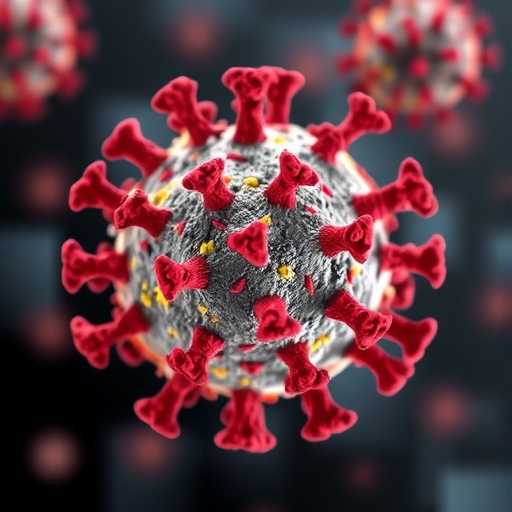In a groundbreaking study that intersects the fields of virology and oncology, researchers have uncovered a novel mechanism by which SARS-CoV-2 mRNA vaccines can sensitize tumours to immune checkpoint blockade therapies. The investigation, published in Nature, explores the complex interactions within the tumour microenvironment (TME) following administration of spike protein-encoding RNA lipid nanoparticles (RNA-LNPs) combined with immune checkpoint inhibitors (ICIs). This pioneering work reveals the potential for vaccine platforms traditionally designed against viral infections to bolster anti-tumour immunity, heralding new frontiers in cancer immunotherapy.
The research primarily focused on the T cell compartment within treated tumours, analyzing the infiltration and activation status of cytotoxic CD8+ T lymphocytes. Utilizing a murine model bearing B16F0 melanoma tumours, the scientists applied a combination of immunofluorescence and flow cytometry to characterize tumour-infiltrating lymphocytes. Their findings highlighted a remarkable expansion of PD-1-expressing CD8+ T cells in treated tumours compared to controls. Specifically, PCR and flow-based assays documented an increase from 2.39% to over 51% PD-1+ CD8+ cells in the tumour milieu, an increase surpassing twentyfold and statistically robust (P 0.0001).
The dominance of PD-1+ CD8+ T cells among the total CD3+ T cell population marks a pivotal immunological shift within the tumour microenvironment following RNA-LNP and ICI therapy. While only 5.69% of total CD3+ cells expressed PD-1 in untreated tumours, this fraction skyrocketed to 60.6% post-treatment (P 0.001), indicating a profound remodeling of the lymphocyte landscape. This suggests that the therapeutic regimen not only attracts large numbers of activated cytotoxic T lymphocytes to the tumour but also skews the immune response towards a PD-1-mediated axis that may be critical for immune checkpoint responsiveness.
To interrogate the antigen specificity of these expanded CD8+ T cells, the researchers employed pooled tetramer staining techniques targeting six epitopes previously identified as relevant in this tumour model. This pan-tetramer approach allowed for sensitive detection amid the generally low frequency of tumour-infiltrating CD8+ cells. The data revealed that, in the combined RNA-LNP and ICI treated group, tetramer-positive CD8+ T cells were nearly doubled (7.98%) compared to controls (3.10%), a statistically significant increase (P = 0.0229). These results confirm that the infiltrating cytotoxic lymphocytes are not merely bystanders but are tumor-reactive immune cells capable of recognizing specific tumour antigens elicited or unmasked by the RNA-LNP treatment.
Complementing these cellular changes, the study showed a striking enhancement of PD-L1 expression on tumour cells themselves following spike RNA-LNP treatment. PD-L1, the ligand of PD-1, serves as a potent immune checkpoint molecule that often mediates resistance to immune clearance. The upregulation of PD-L1 was visualized both by immunohistochemistry and extended data analyses, reinforcing the notion that the responsive tumour microenvironment is undergoing dynamic immune regulatory adaptations. Furthermore, the blockade of IFNα signaling, an essential pathway for antiviral and antitumour immunity, abrogated the PD-L1 induction, underscoring the cytokine’s critical role in orchestrating the immunotherapy response.
Altogether, these mechanistic insights reveal a two-pronged effect of SARS-CoV-2 spike mRNA vaccines administered as RNA-LNPs: they initiate robust activation and recruitment of tumour-specific cytotoxic T cells, simultaneously inducing PD-L1 expression on tumour cells, which sensitizes the tumour to immune checkpoint blockade. This interplay between viral mRNA-triggered innate immunity and adaptive antitumour responses opens the door to repurposing mRNA vaccine platforms widely exploited in the COVID-19 pandemic for next-generation cancer immunotherapies.
The implications of this study extend beyond preclinical melanoma models. The demonstration that synthetic RNA encoding a viral antigen can reprogram the tumour microenvironment to augment checkpoint immunotherapy responsiveness raises exciting possibilities across diverse tumour types. Given the safety profile and manufacturing scalability of mRNA vaccines, there is potential for rapid clinical translation and combinatorial strategies integrating mRNA-LNP technologies with existing immune checkpoint inhibitors like anti-PD-1 and anti-CTLA-4 antibodies.
Moreover, these findings add a novel dimension to the understanding of immune checkpoint therapy resistance. The compensatory upregulation of PD-1 on cytotoxic T cells and PD-L1 on tumour cells often limits the efficacy of ICI monotherapy. The potent induction of these molecules following RNA-LNP administration, paradoxically, creates an exploitable vulnerability — a “checkpoint addiction” that can be effectively targeted by ICIs to unleash tumour-specific T cell cytotoxicity.
Future research will be pivotal in dissecting the molecular pathways downstream of RNA-LNP sensing that lead to IFNα production and subsequent PD-L1 upregulation. Identifying key pattern recognition receptors and interferon-stimulated genes driving this response could further refine therapeutic design. Additionally, exploration of different viral antigens or tumour-associated neoantigen-encoding mRNAs may expand the repertoire of exploitable immune targets.
In summary, this cutting-edge study by Grippin et al. represents a paradigm shift in cancer immunotherapy, highlighting how viral mRNA vaccines can be leveraged to sensitize tumors to immune checkpoint blockade by reprogramming the tumour immune landscape. By combining advanced immunological assays, stringent statistical analysis, and mechanistic insights into interferon signaling, the researchers provide a compelling rationale for innovative combinatorial treatments harnessing the durability of vaccine-induced immunity alongside the potent efficacy of checkpoint inhibitors. As clinical translation accelerates, this approach promises to augment responses in challenging malignancies and redefine the therapeutic potential of mRNA vaccine platforms beyond infectious diseases.
Subject of Research: Use of SARS-CoV-2 mRNA vaccines to sensitize tumours to immune checkpoint blockade therapy.
Article Title: SARS-CoV-2 mRNA vaccines sensitize tumours to immune checkpoint blockade.
Article References:
Grippin, A.J., Marconi, C., Copling, S. et al. SARS-CoV-2 mRNA vaccines sensitize tumours to immune checkpoint blockade. Nature (2025). https://doi.org/10.1038/s41586-025-09655-y
Image Credits: AI Generated
Tags: cancer immunotherapy innovationsCD8+ T lymphocyte activationimmune checkpoint blockade therapiesimmunofluorescence and flow cytometrymurine model B16F0 melanomaPD-1 expressing T cellsRNA lipid nanoparticles in oncologySARS-CoV-2 mRNA vaccinestumor immunotherapy advancementstumor microenvironment interactionstumor-infiltrating lymphocytes analysisvaccine platforms for anti-tumor immunity



